

Rebecca Heineman interview
By Scott Stilphen
(2006)
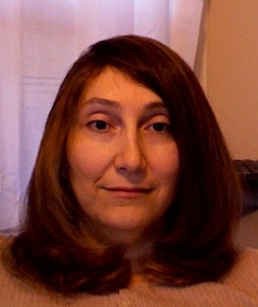
Rebecca estimates she worked on over 250 games throughout her career! Chances are you've played at least one.
Q: Whatís your educational background?
Rebecca Heineman: I have a GED from Whittier High School. I never officially graduated. I started programming and electronics when I was 14, working for JCPenney, a TV repair shop, and then the Electric Planet Arcade. I left home to program computers when I was 16. It wasnít until well after I was working at Avalon Hill did I turn 18 so I could stop lying about my age to get work.
Q: What inspired you to go into game design?
Rebecca Heineman: I love video games. I played pretty much every Apple II and Atari 2600 game there was at the time and I wanted to try my hand at making them.
Q: Were there any programmers or games that inspired you?
Rebecca Heineman: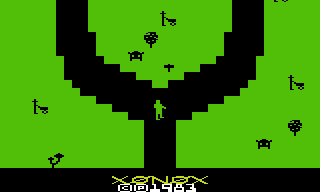 I think Wizardry was the game that inspired a lot of my early think about how games can be made. I lost so many hours playing that from start to finish on my Apple II
I think Wizardry was the game that inspired a lot of my early think about how games can be made. I lost so many hours playing that from start to finish on my Apple II
Q: What titles did you work on?
Rebecca Heineman: All of them. In reality, Iíve worked on over 250 games so far and Iíve actually lost track of some of them. Mindshadow, Tracer Sanction, and Chuck Norris Superkicks (VIC-20) were some of my early favorites.
In early 1983, I wrote the VIC-20 Chuck Norris game, ported over from the Atari 2600 version. The office joke was if you were bad, you get to work on Xonox games. I guess I was really bad. I wrote two, Robin Hood and Chuck Norris Superkicks.
Q: Iím hoping you can help correct our info. We have notes that you did some 2600 games Ė Avalon Hillís London Blitz and Out of Control. We also have notes that say London Blitz was done by William O. Sheppard and Jean Baer, and that Out of Control by Jim Jacob and Jean Baer.
Rebecca Heineman: I worked on a lot of the underlying code. I also did some prototypes. I left Avalon Hill before the games shi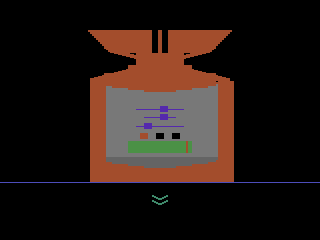 pped,
so I donít know how much of my code stayed in those titles. I was there teaching the programmers how to program the 2600. I did a lot of minor contracting work. I recall doing some work on a Jedi Arena game, but I canít remember if it was used.
pped,
so I donít know how much of my code stayed in those titles. I was there teaching the programmers how to program the 2600. I did a lot of minor contracting work. I recall doing some work on a Jedi Arena game, but I canít remember if it was used.
Q: When did you start at Interplay?
Rebecca Heineman: The real person who started Interplay was Brian Fargo. I was there from day 1 with Jay Patel and Troy Worrell. When Boone Corporation went under, he asked everyone if we wanted to join up with him on his new startup. Of course, I said yes. I was there for 11 Ĺ years and saw it grow from a tiny office of 5 people to a company with over 500.
Q: Were the titles you worked on assigned, or chosen by yourself?
Rebecca Heineman: Many of them were chosen by me during my early years. When I was at EA, I worked on the project I was assigned, although I really enjoyed my work.
Q: Did you work with any graphics or sound artists? If so, do you recall who helped with what?
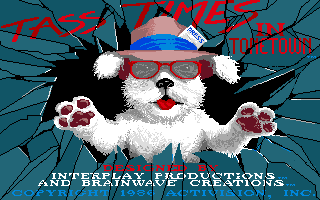 Rebecca Heineman: I worked with a lot of people. Iíve worked with ďThe Fat ManĒ
George Sanger, Kurt Heiden (Bards Tale III: The Thief of Fate, Dragon Wars), Dave Warhol & Russell Lieblich (Tass Times in Tonetown), and Charles Deenen for music and audio. For visuals, thereís Chad Max, Jeff MacAteer, and David Lowery just to name a few. I just took their art and music and made the systems play and show it as closely to the artistís visions as technically possible.
Rebecca Heineman: I worked with a lot of people. Iíve worked with ďThe Fat ManĒ
George Sanger, Kurt Heiden (Bards Tale III: The Thief of Fate, Dragon Wars), Dave Warhol & Russell Lieblich (Tass Times in Tonetown), and Charles Deenen for music and audio. For visuals, thereís Chad Max, Jeff MacAteer, and David Lowery just to name a few. I just took their art and music and made the systems play and show it as closely to the artistís visions as technically possible.
Thereís hundreds Iíve worked on. Usually, my games are designed by others and I update the design to make it feasible for use on a computer. I add a lot of prose after the fact for filler when itís discovered that there were ways a game can be played that the original designer didnít take into account.
Q: What was the easiest/hardest part of designing each one?
Rebecca Heineman: The easiest for me is coming up with how to implement a game. I always envision in my head what the game sh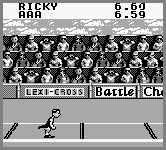 ould
look like on the screen before a line of code is written. Then I design the code to work with that. It allows me to get the game up and running in a very short period of time.
ould
look like on the screen before a line of code is written. Then I design the code to work with that. It allows me to get the game up and running in a very short period of time.
The hardest? That had to be Track Meet for the Gameboy. The game design was totally changed every few weeks so I had to keep starting the project over from scratch until it was done. This made a 3 month project take almost a year.
Q: With your games, were there any features you would have liked to added, or any known bugs or glitches that gave you trouble (or never got resolved)?
Rebecca Heineman: Always. Sadly, there are nowhere near enough hours in a day to even try to go back to some of my favorite ones and update them. Maybe when I retire in 30 years.
Q: If you had a chance to redo any of your games, what would you change (if anything)?
Rebecca Heineman: Iíd do Wasteland II. Period.
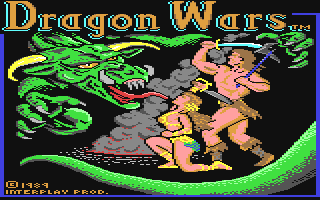 Q: Do you remember what early or tentative titles your other games had
(if any)?
Q: Do you remember what early or tentative titles your other games had
(if any)?
Rebecca Heineman: Bardís Tale IV was a title I had until I was told a month before release we couldnít use the name. So, Dragon Wars the name was handed to me. Too bad there werenít any dragons in the game at the time. So I had to add one.
Graphics Master for the Apple II (released in 1987) was originally called QuickDraw, which was a graphics editor I wrote in 1984 to draw the art in Mindshadow and Tracer Sanction. Later, I turned it into a basic art program which was used for Bard's Tale, Tass Times in Tone Town, Wasteland, and many other Apple II and C-64 titles at Interplay.
Q: Were there any games or projects that you worked on that ultimately never got released or even finished?
Rebecca Heineman: Half Life for the Mac. It was done. Then Valve decided they didnít want to release it. It was a really sad day at the office when the news hit.
In 1983, I wrote a 3D space shooter for Boone called Final Eclipse. Boxes were made, since I have one. It's the ongoing saga of Captain Brian Fargo, and how he saved the Earth from being a block of ice. This game was never released.
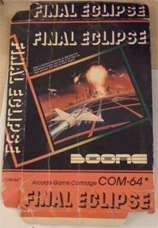
Q: Do you recall any other titles that other programmers were working on that were never released, or finished?
Rebecca Heineman: There were quite a few. Abducted at Contraband is the most recent. Although, there may be hope yet recently that that title will finally see the light of day.
Q: You were well-known for putting (burger-related) Easter eggs in your games- most them involving burgers and/or axes Ė one game in particular (for the 3DO) had a trick that revealed a drawing of a guy chopping another guy's head off with an axe!
Rebecca Heineman: Yes, that picture is in Out of This World. Iíve lost count of how many games I snuck that into. I stopped doing it over 10 years ago.
I had the nickname Ďburgerí, and as a way of getting back at my co-workers, I had the word burger do something horrible to the character. The axe picture was originally drawn by David Lowery for Brian Fargo so he could play a joke on me. He had that put onto my startup screen on my Apple II because he said, "If you say Ďburgerí one more time, I'm going to lop your head offĒ. So, Iíve been lopping off characterís heads ever since. And burgers slice well with sharp axesÖ
Q: You also once had a column in Electronic Games about Easter eggs?
Rebecca Heineman: I wrote a series of articles in Electronic Games in the early 80ís. I wish I had a copy of the articles, but my archives of them have been lost to time.
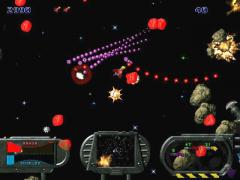 Q: How did Logicware (which you founded) come about? Was AstroRock 2000 the only game you did there?
Q: How did Logicware (which you founded) come about? Was AstroRock 2000 the only game you did there?
Rebecca Heineman: After 11 years at Interplay, it was time to move on. I didnít like the fact that Interplay was a huge company that didnít seem to know what they wanted to focus on. I missed that.
There were quite a few titles that Logicware as a company did. We did work for 3DO, Interplay, Id, Activision, MGM Interactive, and Avalon Hill.
Q: Youíre also involved with Barking Lizards and/or Contraband Entertainment. What is your Ďtimelineí with respect to these two companies?
Rebecca Heineman: I own Contraband Entertainmentís assets. Currently, Iím an independent contractor whoís doing work for Barking Lizards in Dallas. Iím right now looking at some job offers so I may be settling down again really soon.
Q: Did you ever attend any industry shows, such as CES or Toy Fair?
Rebecca Heineman: I went to CES every year until E3 appeared. Then I attended every E3 since although it looks like E3 is gone. I also occasionally attended The Game Developers Conference and the Classic Gaming Expo.
Q: Do you still own any of your games for these systems, either as a keepsake, or to show friends or family?
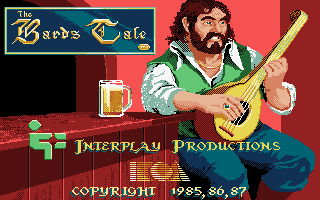
Rebecca Heineman: Yes. I have a huge Atari 2600 collection and a large storage room filled to the ceiling with my classic games. Many of my games are still shrink-wrapped.
Q: Which of your titles are your favorite, and what types of games in general?
Rebecca Heineman: I like first-person shooters and role-playing games (hmmÖ. Wasteland and Bardís Tale). I also have a weakness for the classic Doom. And I play that from time to time against my son in deathmatch mode.
Q: Have you stayed in touch with any of your former co-programmers?
Rebecca Heineman: Iíve mostly stayed in touch. I sometimes get a pleasant surprise when someone from my past appears when I least expect it (like, walking down the halls of Electronic Arts) and we say hi and reminisce.
Q: What were some of your experiences working for each company? Any stories or anecdotes from those days that you recall?
Rebecca Heineman: Working from Chris Jacobsonís apartment when we were trying to get Contraband off the ground was a fond memory.
Q: What are your thoughts on how the industry has evolved?
Rebecca Heineman: Itís interesting how itís come full circle. These hand-held phones require games that pretty much are games intended for the C-64. I enjoyed working on some J2ME titles a few years back. It reminded me of the old days. Now, most games are really interactive versions of a movie, complete with scriptwriting, name actors and full orchestras performing the music. Sadly, many games forgot that they are supposed to be a game and not a movie.
Q: You were mentioned in Tom Hirschfeld's books, How to Master the Video Games and How to Master Home Video Games (page 61) about being the Atari VCS Space Invaders National Champion in 1980 (and also the first-ever recognized National Video Game Champion); articles also appeared in first issue of the Atari Age newsletter, and the March 1981 issue of Creative Computing), and beating out over 10,000 players with a top score 165,200 in 2 hours! What do you recall from that experience?
Rebecca Heineman: Yes, I did win. I had two strategies. One was "slow and steady", which won the L.A. tournament, and the other was "kill everything on the screen ASAP", which won me the NYC finals. In the finals, I took an hour and 45 minutes to get the highest score. I lost one or two bases because my strategy was riskier, but faster. It paid off and I won.
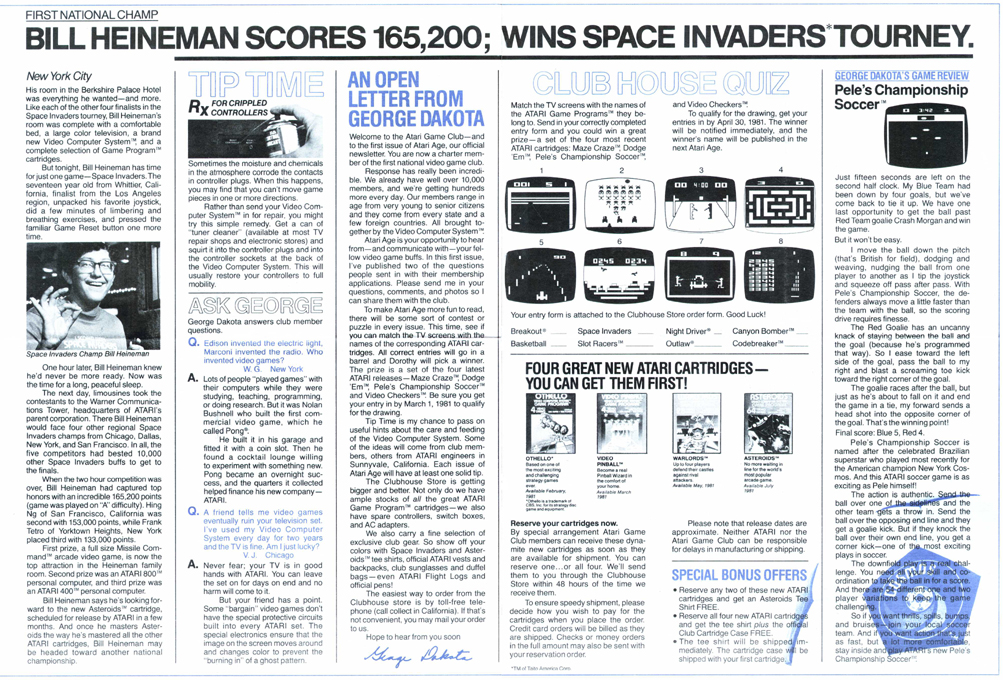
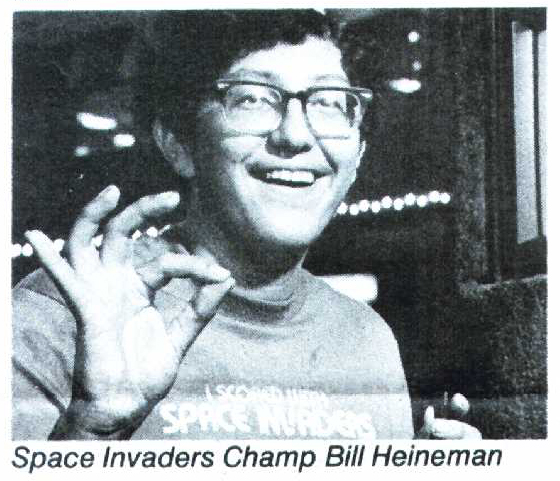
Article and photo from the 1st issue of the Atari Age newsletter.
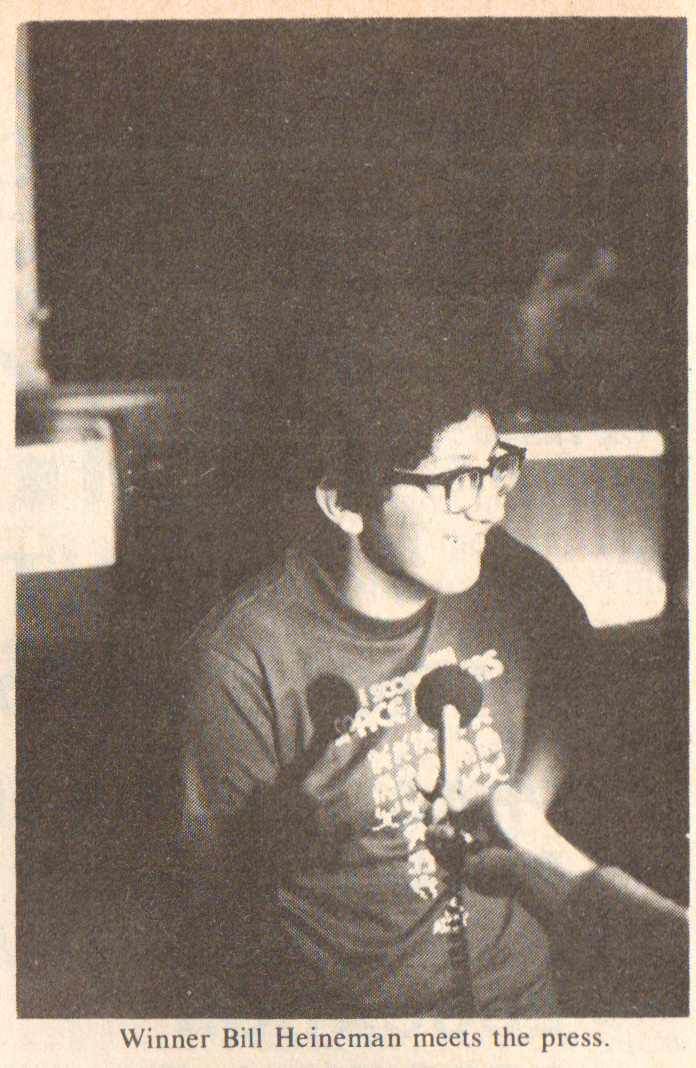
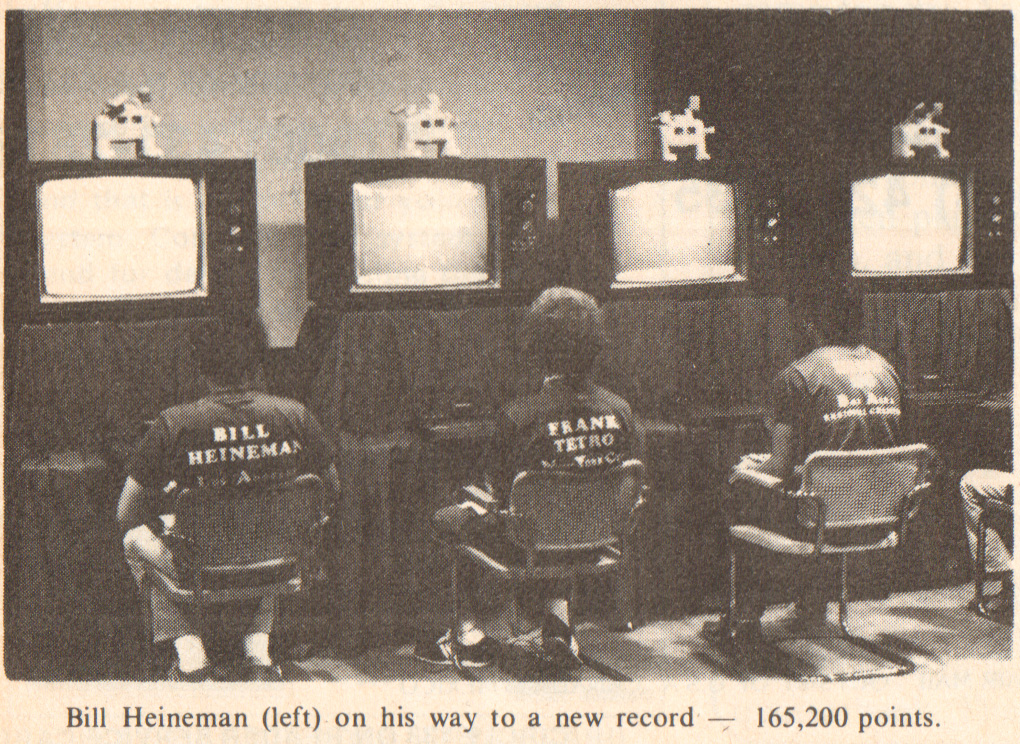
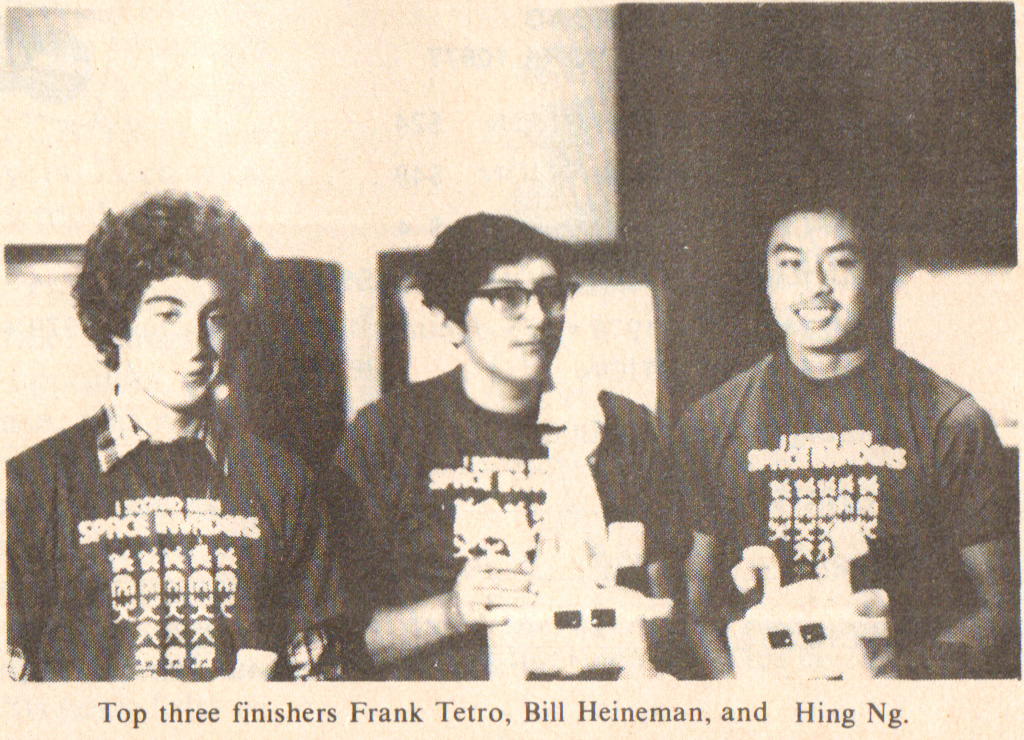
Photos from the March 1981 issue of Creative Computing. The other finalists - listed from 2nd to 5th place were
Ning Ng (San Francisco, CA), Frank Tetro Jr. (Yorktown Heights, NY), Robert Marek (Dallas, TX), and Steve Marmel (Chicago, IL).
Here's a PDF of the Creative Computing article about the First National Space Invaders Championship. The following comes from an interview she did with Matt Barton in 2010 (the live video chat is on YouTube and the transcription of it is on Gamasutra) where Rebecca talks about the Space Invaders contest:
| "I had a friend named Tom Whicker. He and I would play video games all the time. I didn't have much money, so I had a 2600 and an Apple II, and I was copying the cartridges - I designed my own "dev kit," shall we say - because I was just too flat broke. But he had every single cartridge made. So I would grab it and copy it from him. We played Slot Racers and Space Invaders all the time. Atari announced that there was going to be a Space Invaders tournament at the Topanga Canyon Plaza sometime in July in 1983. He was convinced that I had to be good. I was like, "Yeah, right." So he drives me up, and as it's my turn, I start playing and I'm so bored playing this game. I was talking with the judge because I had nothing better to do. I was like, "Oh, I just lost a base." and play, play, play, play, and another hour would go by. Base, play, play, play. "What's my score?" And he said, "You've got like 83,600 points." And of course, my reply was ,"Is that good?" As it turns out, it was more than double the second-place player. They announced that I was the winner. I was like, "You're kidding me? I'm going to New York for the finals?" So, in November I flew by myself to New York City to play in the championships. Just so you know, back then I was a loner. I lived by myself. I flew to NYC, met the other contestants. The kid from Dallas, we kept calling him Tex, and the kid from Chicago was being sponsored by some appliance store. He had this big T-shirt on him and was like the total sponsor hog. Of course, when the game played, the aliens landed on him in ten minutes. So he got kicked out. So they finally started the game. They had five TVs, five Ataris, and they gave each one of us a shirt with our cities on it. Mine said Los Angeles. It was sudden death. We'd just play the game, and we'd get three bases, maximum difficulty level, and the idea was to see who'd be the last man standing. After an hour and 45 minutes, only the guy from Chicago was out. Everyone else was still just killing the aliens. They had a whole bunch of press behind us, and they were getting antsy, because an hour and 45 minutes of Space Invaders does get kind of boring. So then they just said, "Okay, so that concludes the Space Invaders tournament!" I was like, "Does that mean we can stop playing?" I just reached over and yanked out the cartridge, and said, "That's it! I'm done with this game!" I wanted the Atari 800 computer that was the second-place prize. The fifth place was a $50 gift certificate, the next one was $100 worth of stuff and a video game collection, but the Atari 800 computer - oh, gosh - I really wanted one. Because the grand prize was a stand-up arcade game, and I didn't want that. So they then said fifth-place goes to Chicago, fourth-place goes to Texas, third-place went to Hing Ning of San Francisco. I was sitting there going, "I got the computer! I got the computer!" And then when they said the computer goes to Frank Tetro of New York, I went, "Crap!" Then they said, "The winner of the Space Invaders Tournament is the kid from Los Angeles!" So they asked me how I felt. "Uhh, uhh. " But because I won that tournament, I got to meet up with Arnie Katz and Bill Kunkel of Electronic Games magazine and started writing some articles for them on how to beat video games. I was a consultant for a book called How to Master the Video Games and How to Master Home Video Games." |
Q: There's some discrepancies with what was published in Atari Age and Creative Computing, and with some of the statements you made in Matt Cohen's interview. The Atari Age Space Invaders contest article stated you were 17, and the prize was a full-size Missile Command arcade machine. The Creative Computing article says you were 16, and the prize was a cocktail table Asteroids arcade machine, as did the Winter 1981 issue of Electronic Games (which also states the prizes were on display).
Rebecca Heineman: I was both 16 and 17. You see, I was born October 30th, 1963. I was 16 when the Los Angeles regional was held in July of 1980, but I just turned 17 when I played the finals. The finals were held on November, just a few days
after my birthday. You could almost say that my 17th birthday present was to be crowned National Champion.
The listed prize was an upright arcade Asteroids machine, and I remember seeing one in another room at Atari HQ, but there were other machines too. Itís possible there was confusion since there were about a dozen different machines around the floor. I got a tour of Atariís headquarters, so likely Iím remembering rooms the general press didnít get to see. However, I asked if I could swap it out for a tabletop Missile Command because I didnít have room in my apartment for the
Asteroids machine and Atari was kind enough to oblige. I had that machine for many years before it was sold to pay for a divorce.
Q: The 2nd page of the Creative Computing article talks about your strategy and describes how you play "at each reset"! What's this? Were the players resetting the game after clearing the first wave?
Rebecca Heineman: I recall it like it was yesterday. When they said ďresetĒ, they meant the game simply started the next wave. We had to play the entire game in the ďwide baseĒ mode. Any attempt to touch the difficulty switch to change to the smaller base would get you immediately disqualified. I learned to time the base precisely so I can play forever at the high difficulty, as did the other regional champions. I played my 2600 recently and ďIíve still got itĒ - played Space Invaders non-stop for almost an hour before I had to stop because it was getting monotonous.
Q: Did the regional contest for Space Invaders have a time limit as well?
Rebecca Heineman: In the Los Angeles regional, there was no time limit. You paid $1 to enter and played until you died. I ended up playing for over an hour until the invaders landed on me, mostly from boredom. I wasnít at the other regional contests, but I had heard they changed some rules, like adding time limits, mostly to earn more money because having a station tied up for an hour costs them money.
Q: Do you still have your original VCS development kit you made (prior to the contest)?
Rebecca Heineman: Yes, I still have the ROM emulator in a box that I used to write my 2600 games.
Rebecca also sent me the following photos and captions when I was interviewing her. I didn't include them originally but have added them now:
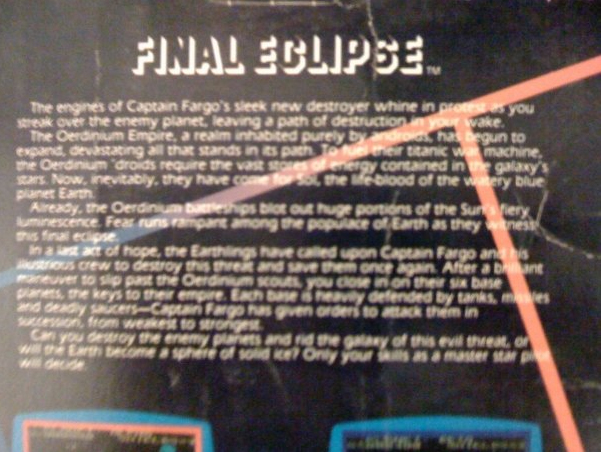
Rebecca Heineman: I am such a dead woman. Brian is so going to kill me for posting this. Brian Fargo, the former CEO of Interplay Productions and current CEO of InXile Entertainment hated the fact that he was cast as the star of Boone Corporation's action games.
Here's the text from the Final Eclipse box:
| "Final Eclipse(tm) The engines of Captain Fargo's sleek new destroyer whine in protest as you streak over the enemy planet, leaving a path of destruction in your wake. The Oerdinium Empire, a realm inhabited purely by androids, has begun to expand, devastating all that stands in its path. To fuel their titanic war machine, the Oerdinium droids require the vast stores of energy contained in the galaxy's stars. Now, inevitably, they have come for Sol, the life-blood of the watery blue planet Earth. Already, the Oerdinium battleships blot out huge portions of the Sun's fiery luminescence. Fear runs rampant among the populace of Earth as they witness this final eclipse. In a last act of hope, the Earthlings have called upon Captain Fargo and illustrious crew to destroy this threat and save them once again. After a brilliant maneuver to slip past the Oerdinium scouts, you close in on their six base planets, the keys to their empire. Each base is heavily defended by tanks, missiles and deadly saucers - Captain Fargo has given orders to attack them in succession, from weakest to strongest. Can you destroy the enemy planets and rid the galaxy of this evil threat, or will the Earth become a sphere of solid ice? Only your skills as a master star pilot will decide." |
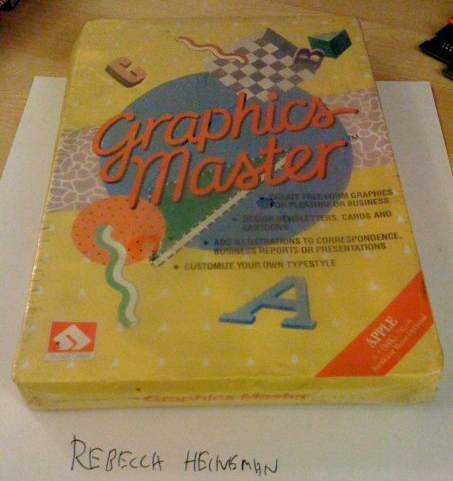
Rebecca Heineman: Graphics Master for the Apple II (released in 1987) was originally "QuickDraw", a graphics editor I wrote in 1984 to draw the art in Mindshadow and Tracer Sanction. Later, I turned it into a basic art program which was used for Bard's Tale, Tass Times in Tone Town, Wasteland, and many other Apple II and C-64 titles at Interplay.
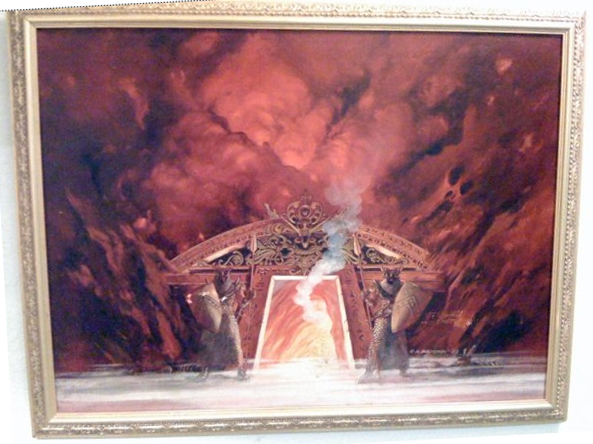
Rebecca Heineman: This is an original oil painting that was used for the box art on the game I worked on in 1982 called Demon's Forge. The game was originally written by Brian Fargo in Applesoft BASIC. I re-wrote it into Assembly and my ADVENT scripting language that was used for Mindshadow. This painting currently is hanging on my wall.
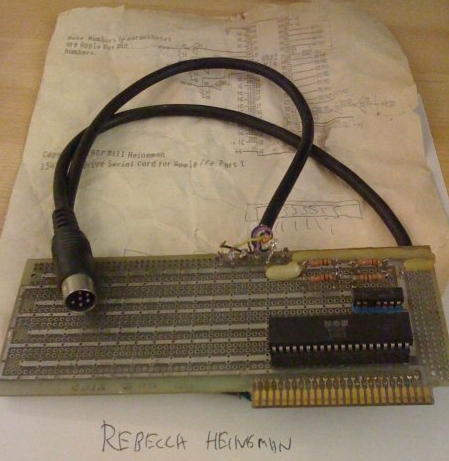
Rebecca Heineman: OMG! My Apple II to Commodore 1541 drive adapter I made in 1982 so I could write C-64 games using my Apple II. I even have my original schematic and tech notes.
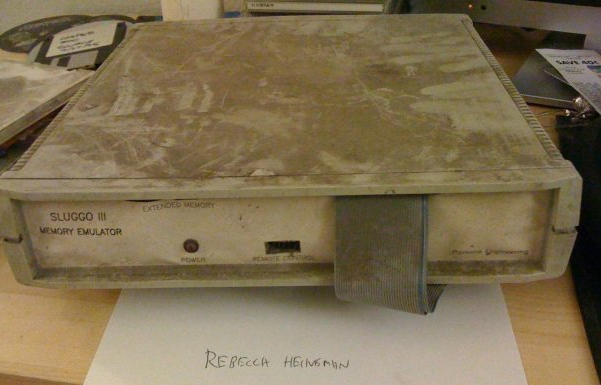
Rebecca Heineman: A Sluggo III ROM emulator I built to develop Atari 800, C-64, and Nintendo NES and SNES games with. She sure didn't age very well.
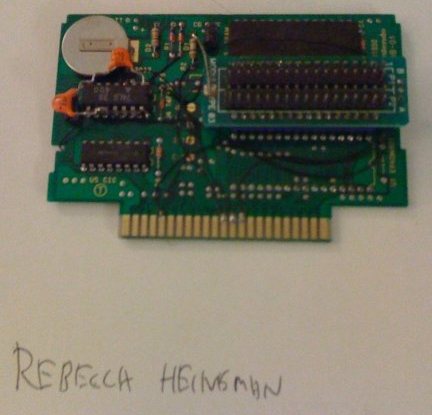
Rebecca Heineman: A Sluggo III personality module to allow connection to the Nintendo SNES. I used this to develop Wolf 3-D, Out of This World, and the audio on RPM Racing.
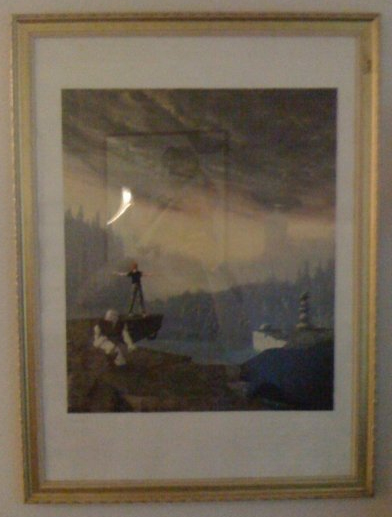
Rebecca Heineman: This is a signed print given to me personally by Eric Chahi, the original designer of Another World, or as it's known in the USA as Out of this World. It was in appreciation for my work in getting the game onto the Super NES. It's currently hanging in my living room wall.
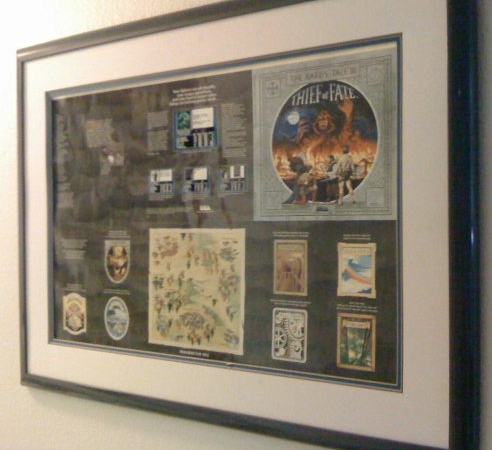
Rebecca Heineman: This is a framed, unfolded print of the package for Bard's Tale III: The Thief of Fate. It was a gift from Electronic Arts to me when the game sold over 100,000 copies. It's hanging in my hallway.
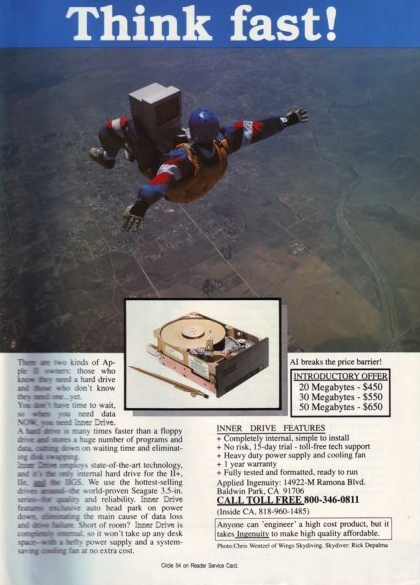
Rebecca Heineman: I wrote the firmware for the Applied Ingenuity Innerdrive in the 1990's. David Westbrooke wanted to do an ad that would grab some attention and since he was a skydiver, this ad was thought up and shot. It became the most talked about ad for years in the Apple II world.
You have to admit, it's catchy.
The monitor was hollowed out and a piece of plastic stood in for the monitor glass. The computer had no power supply or peripheral cards during the jump, but the motherboard was inside. The Apple IIgs casing was held on the jumper via Velcro, as was the keyboard. It took 3 jumps to snap this shot. Good thing - on the third jump the keyboard fell off and smashed on the ground below.
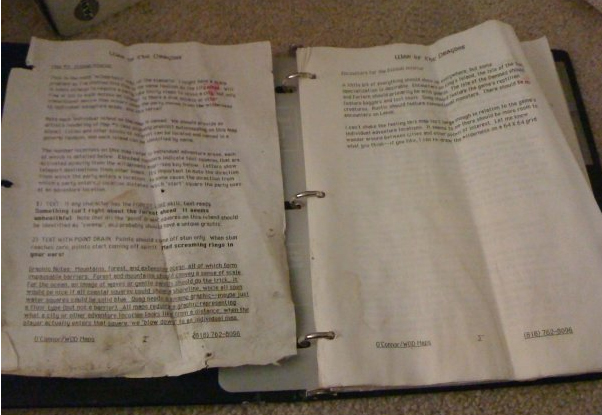
Rebecca Heineman: This is the original game design document for what became Dragon Wars. It was first written by Paul Ryan O'Connor, the author of Grimtooth's Trap. This game was intended to be Bard's Tale IV with some of the open world abilities of Wasteland.
Since EA and Interplay split up, Interplay couldn't use the name Bard's Tale, so we went with Dragon Wars instead. Despite critical acclaim, the game did mediocre sales and it became the last fantasy RPG I have written. Dragon Wars was released in 1989.
The book is filled with hand written notes from Paul and myself, and all the maps are found in the back, written by hand on graph paper. The paragraph book's original draft and my programming notes round out the over 130 pages in this folder.
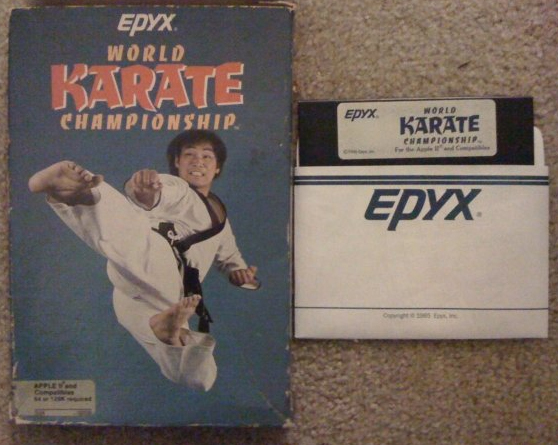
Rebecca Heineman: In 1986 I did a port of a C-64 game to the Apple ][ for Epyx called World Karate Championship. The game came out quite faithful to the original because I used the C-64 code as-is and wrote a C-64 to Apple ][ screen buffer translator and made the main code think it was still on a
C-64.
During this time in my life, I was churning out games at breakneck speed; I was taking on extra side projects to supplement my meager income. In Interplay's early years, I was paid (as was everyone else) slave wages.
Interplay was a start up at the time. What can I say? I was young. I needed the work.

Rebecca Heineman: In the early years of Electronic Arts, they held an annual "Artists Symposium" where many of those from independent studios gathered together in Silicon Valley to exchange ideas on current and future titles, and swap technology amongst one another. Each attendee got a commemorative
glass mug engraved with the year of attendance. Here are my mugs for attending the 1985 and 1987 conferences. I had others, but they had been destroyed over the years. 1985 was for Bard's Tale I, and 1987 was for Wasteland and Bard's Tale III. 1988 was my last year of attendance.
They read "Electronic Arts 1985 Artist Symposium"
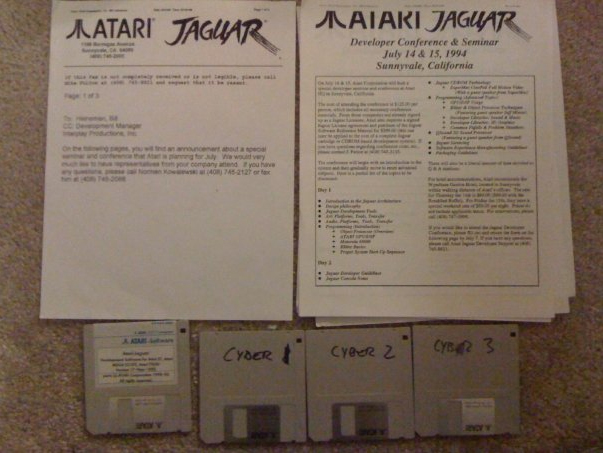
Rebecca Heineman: Interplay was thinking about doing Atari Jaguar development in 1994. Since I was the poor girl who learned new systems the fastest, I was given a box of documentation, an Atari ST, and the source code to the game Cybermorph so I could start porting Interplay titles to the Jaguar. Eventually, I did a port of DOOM to the 3DO, and id software gave me the source to DOOM for the Jaguar as a starting point, so my experience on the Jaguar came in quite handy.
Yes, those floppies contain the source to Cybermorph (I have no idea if the disks are still readable).
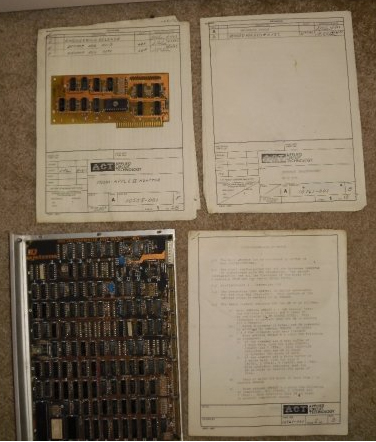
Rebecca Heineman: In 1983, when Boone Corporation was floundering, I took on a project with Applied Circuit Technology where I re-wrote their hard disk controller so it could use 10, 20, and 30 MB hard drives, since it was hard-wired to use only 5MB Seagate hard drive mechanisms.
A few years later, I ended up with over 50 of these enclosures, and I sold drives for Apple II users with this hardware. I also wrote ProDOS (then GS/OS) device drivers to support the Apple II interface card (shown).
In the picture is that actual motherboard that did RLL hard drive read/writes, and Apple II interface card, the printout of the ORIGINAL source code for the motherboard, and the complete schematics for both cards.
This experience allowed me to move on to work on the InnerDrive Driver (Applied Ingenuity), Focus Drive Driver and circuit designs (Parsons Engineering), and a home brew Vulcan (Applied Engineering) GS/OS driver.
| GAME | SYSTEM | COMPANY | STATUS |
| London Blitz | Atari VCS/2600 | Avalon Hill | released |
| Out of Control | Atari VCS/2600 | Avalon Hill | released |
| Penetrator | Atari VCS/2600 | Avalon Hill | unreleased |
| Chuck Norris Superkicks | VIC-20, C-64 | Xonox (Boone Corporation) | released |
| Robin Hood | VIC-20 | Xonox (Boone Corporation) | released |
| Final Eclipse | C-64 | Boone Corporation | unreleased |
| Demon's Forge, The (rewrite) | Apple II | Boone Corporation | released |
| Borrowed Time | Apple II, C-64 | Interplay / Activision | released |
| Graphics Master | Apple II | ShareData | released |
| Mindshadow | Apple II, C-64 | Interplay / Activision | released |
| The Tracer Sanction | Apple II, C-64 | Interplay / Activision | released |
| World Karate Championship | Apple II | Epyx | released |
| Wasteland | Apple II | Interplay / EA | released |
| Bard's Tale I: Tales of the Unknown | Apple IIGS, C-64 | Interplay / EA | released |
| Bard's Tale II: The Destiny Knight | Apple IIGS, C-64 | Interplay / EA | released |
| Bard's Tale III: The Thief of Fate | Apple IIGS, C-64 | Interplay / EA | released |
| Dragon Wars (aka Bard's Tale IV) | Apple IIGS, C-64, PC | Interplay | released |
| Out Of This World | Apple IIGS, SNES, MAC, 3DO | JVC / Interplay | released |
| Rescue Rover | Apple IIGS | Softdisk | released |
| Tass Times in Tonetown | Apple IIGS, C-64 | Iinterplay | released |
| Ultima I | Apple IIGS | Origin | released |
| Wolfenstein 3-D | Apple IIGS, SNES, MAC, 3DO | Id | released |
| Track Meet | Gameboy | Interplay | released |
| RPM Racing (audio) | SNES | JVC / Interplay | released |
| Rock and Roll Racing | SNES | Interplay | released |
| Doom | 3DO | Logicware / Art Data | released |
| Outer World | 3DO | Delphine Studios / Interplay | |
| AstroRock 2000 | MAC, PC | Logicware | released |
| Chitty Chitty Bang Bangís Adventures in Tinkertown | MAC, PC | Logicware | released |
| Descent | PC | Interplay | released |
| Defiance | PC | Logicware | released |
| Medal of Honor: Pacific Assault | PC | EA | released |
| Aliens vs. Predator | MAC | Fox / Logicware | released |
| Crosman Air Gun Challenge | MAC, PC | Logicware | released |
| Half-Life | MAC | Logicware | released |
| Heretic II | MAC | Contraband | released |
| Jazz Jackrabbit II | MAC | Logicware | released |
| Kingdom: The Far Reaches | MAC, 3DO, PC | Logicware | released |
| Monster Hunter | MAC, PC | Contraband | released |
| Quake II | MAC | Logicware | released |
| Remington Top Shot | MAC, PC | Logicware | released |
| Shadoan | MAC, PC | Logicware | released |
| Shattered Steel | MAC | Logicware | released |
| SiN | MAC | Contraband | released |
| Zork: The Grand Inquisitor | MAC, PC | Contraband | released |
| Activision Anthology | PS2 | Contraband | released |
| Goldeneye: Rogue Agent | PS2, XBOX, GC | EA | released |
| Medal of Honor: European Assault | PS2, XBOX, GC | EA | released |
| Medal of Honor: Rising Sun | PS2, XBOX, GC | Contraband | released |
| Battle for Middle Earth II | XBOX 360 | EA | released |